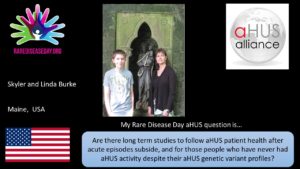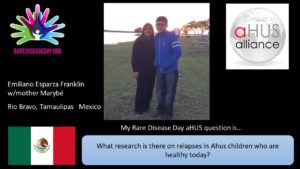What is certain is that aHUS patients vary.
Like many health conditions there are considerable differences between aHUS patients in terms of triggering of onset , symptoms , response to treatments and its withdrawal, as well as clinical outcomes. There are differences between patients whose encounter has been very recent and those who faced aHUS decades ago.
aHUS people are different from each other even though sometimes their DNA suggests they are the same.
Even before the advent of eculizumab some people survived the encounter with aHUS , and without the need for long term dialysis. Their over active uncontrolled complement returned to a normal tick over as the embers of aHUS slowly glowed less and less , and then extinguished. They went into a state of remission where the signs and symptoms of aHUS disappeared; such remission could be permanent or temporary.
In the Rare Disease Day video Skyler of Maine , USA asks ” Are there any long terms studies to follow aHUS patients after the acute episode subsides”

An individual patient’s medical record is the basic study of clinical outcome post remission. These are often aggregated into national databases or registries so that researchers can monitor outcomes over time ( or “longitudinally” in researchers speak) . There were three long term studies about all the patients who accessed eculizumab during the trials of the drug which begun in 2009. These long term studies have now come to an end; and there will be a Report published in September this year.
However these long term studies do not end there Skyler, because with the permission of patients their experience can still be followed through participation in the aHUS Registry, which will continue its observations until 2025. Not all patients in the aHUS registry are receiving eculizumab some are in remission ,and, out of 1500 total number of patients currently enrolled, several hundred are not being treated still.
How temporary a remission might be is clearly a concern for those who are in remission and well. Emiliano of Rio Bravo Tamaulipas Mexico asks ” What search is there on relapse in aHUS children who are healthy today”.

Again the aHUS Registry will be tracking relapses , examining in what circumstances they happen and what are the patient characteristics of those who do ( e.g. the genetic predisposition) . It would also be important to know what impact the relapse had on health. This study is known as the EVIDENCE study and will be recruiting patients from within the aHUS Registry , it is anticipated that over 300 patients will be enrolled. Note Alexion pulled the plug on this research and the EVIDENCE study was stopped.
There are many anecdotes in the aHUS social media of aHUS patients who have gone into remission. Indeed it seems to the author that boys who encounter the disease at an early age , and most research shows that more boys than girls face aHUS at an early age , are the most likely ( but not exclusively) to go into long term remission.
Landon of Ohio’s mother , USA asks ” Landon has CD46 / MCP mutation . With that mutation what are the chances of aHUS being triggered again. He is not on eculizumab but does monthly labs and his labs and kidneys have been fine after one moth of his diagnosis /illness.”

Nearly six years ago in August 2011 there was a blog by Bill Bierman of the Foundation for ( children with ) atypical HUS about remission ( it is still visible at time of writing click here ) . A contributor to the discussion mentions her son Josh who has a CD46/ MCP predisposition. At that time Josh had been in remission for three years, and is still so today, Landon.
aHUS is a disease of small biological differences triggered by one hit from very very many injurious events. It is down to probabilities and chance, as well as genetics, which themselves are also down probabilities and chance.
aHUS Research closes the knowledge gap bit by bit.
In the meantime one thing is for sure nothing is certain, whether good or bad, as aHUS patients vary

